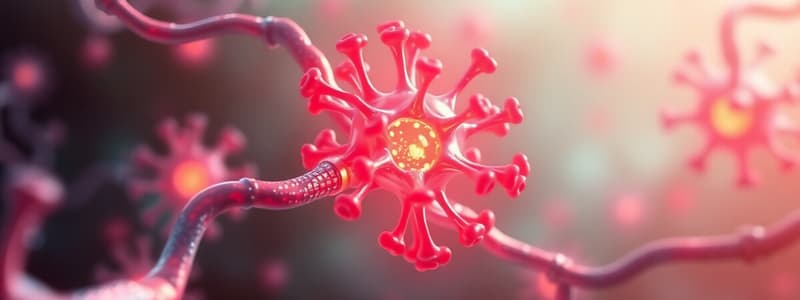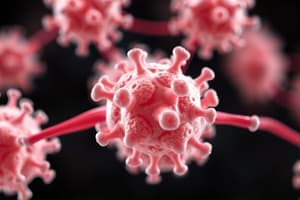Podcast
Questions and Answers
What is the primary mechanism of action of H3-receptor antagonists like Pitolisant in the treatment of narcolepsy?
What is the primary mechanism of action of H3-receptor antagonists like Pitolisant in the treatment of narcolepsy?
- They enhance the effects of adrenaline.
- They block the release of serotonin.
- They increase the synthesis and release of histamine. (correct)
- They inhibit the synthesis of histamine.
Which of the following adverse effects is most commonly associated with first-generation antihistamines?
Which of the following adverse effects is most commonly associated with first-generation antihistamines?
- Cardiac toxicity
- Labyrinthine disorders
- Digestive obstruction
- Sedation (correct)
Which of the following is NOT a clinical use for second-generation antihistamines?
Which of the following is NOT a clinical use for second-generation antihistamines?
- Allergic conjunctivitis
- Urticaria
- Allergic rhinitis
- Motion sickness (correct)
What type of reaction can injectable formulations of antihistamines like epinephrine address?
What type of reaction can injectable formulations of antihistamines like epinephrine address?
What is one potential interaction that could increase the risk of cardiac toxicity with second-generation antihistamines?
What is one potential interaction that could increase the risk of cardiac toxicity with second-generation antihistamines?
Which of the following is NOT a reason for the preference of second-generation antihistamines over first-generation ones?
Which of the following is NOT a reason for the preference of second-generation antihistamines over first-generation ones?
Which class of antihistamines is indicated for the treatment of excessive daytime sleepiness in narcolepsy?
Which class of antihistamines is indicated for the treatment of excessive daytime sleepiness in narcolepsy?
Which of the following side effects is characteristic of anticholinergic effects related to antihistamine use?
Which of the following side effects is characteristic of anticholinergic effects related to antihistamine use?
Which type of receptor is primarily involved in causing bronchoconstriction as a response to histamine?
Which type of receptor is primarily involved in causing bronchoconstriction as a response to histamine?
What is the primary clinical use of H1 antagonists?
What is the primary clinical use of H1 antagonists?
Which receptor type is associated with enhancing gastric acid secretion?
Which receptor type is associated with enhancing gastric acid secretion?
Which class of antihistamines is indicated for the treatment of narcolepsy?
Which class of antihistamines is indicated for the treatment of narcolepsy?
Histamine's role in the innate and acquired immune response is primarily mediated through which receptor?
Histamine's role in the innate and acquired immune response is primarily mediated through which receptor?
What effect does the activation of H1 receptors have on vascular permeability?
What effect does the activation of H1 receptors have on vascular permeability?
Which physiological action of histamine is NOT mediated by the H2 receptor?
Which physiological action of histamine is NOT mediated by the H2 receptor?
What is the mechanism of action of H2 antagonists?
What is the mechanism of action of H2 antagonists?
What is the main difference between antihistamine antagonists and inverse agonists?
What is the main difference between antihistamine antagonists and inverse agonists?
Which of the following drugs is classified as a first-generation antihistamine?
Which of the following drugs is classified as a first-generation antihistamine?
Which action is not associated with first-generation antihistamines?
Which action is not associated with first-generation antihistamines?
What is the principal manifestation of an overdose of first-generation antihistamines?
What is the principal manifestation of an overdose of first-generation antihistamines?
Which of the following statements accurately describes the mechanism of action of H1-receptor inverse agonists?
Which of the following statements accurately describes the mechanism of action of H1-receptor inverse agonists?
Which characteristic is primarily true for second-generation antihistamines?
Which characteristic is primarily true for second-generation antihistamines?
Which enzyme is primarily responsible for the metabolism of most orally active antihistamines?
Which enzyme is primarily responsible for the metabolism of most orally active antihistamines?
What is the therapeutic effect of administering an acetylcholinesterase inhibitor during anticholinergic toxicity?
What is the therapeutic effect of administering an acetylcholinesterase inhibitor during anticholinergic toxicity?
Flashcards
Histamine's role in inflammation
Histamine's role in inflammation
Released from mast cells, histamine triggers inflammatory reactions by causing changes in blood vessels and promoting immune responses.
Histamine receptors
Histamine receptors
Four types (H1-H4) of histamine receptors exist, each triggering different signaling pathways in the body.
H1 receptors' action
H1 receptors' action
Mediates smooth muscle contraction and vasodilation, particularly in the inflammatory response, and sensory nerve stimulation (itching).
H2 receptors' function
H2 receptors' function
Signup and view all the flashcards
Histamine synthesis
Histamine synthesis
Signup and view all the flashcards
Histamine metabolism
Histamine metabolism
Signup and view all the flashcards
Histamine's role in allergic reactions
Histamine's role in allergic reactions
Signup and view all the flashcards
Histamine's role in sleep-wake cycle
Histamine's role in sleep-wake cycle
Signup and view all the flashcards
Histamine Receptor Antagonists
Histamine Receptor Antagonists
Signup and view all the flashcards
Allergic Rhinitis Treatment
Allergic Rhinitis Treatment
Signup and view all the flashcards
Narcolepsy Treatment
Narcolepsy Treatment
Signup and view all the flashcards
Adverse Effects (Antihistamines)
Adverse Effects (Antihistamines)
Signup and view all the flashcards
Second-Generation Antihistamines
Second-Generation Antihistamines
Signup and view all the flashcards
CYP3A4 Inhibitors
CYP3A4 Inhibitors
Signup and view all the flashcards
Drug-Induced Photosensitivity
Drug-Induced Photosensitivity
Signup and view all the flashcards
Anti-emetic use
Anti-emetic use
Signup and view all the flashcards
Antihistamines
Antihistamines
Signup and view all the flashcards
H1-receptor antagonist
H1-receptor antagonist
Signup and view all the flashcards
H1-receptor inverse agonist
H1-receptor inverse agonist
Signup and view all the flashcards
Blood-brain barrier
Blood-brain barrier
Signup and view all the flashcards
First-generation antihistamines
First-generation antihistamines
Signup and view all the flashcards
Chlorphenamine(example)
Chlorphenamine(example)
Signup and view all the flashcards
Anticholinergic syndrome
Anticholinergic syndrome
Signup and view all the flashcards
Anticholinergic Toxicity Treatment.
Anticholinergic Toxicity Treatment.
Signup and view all the flashcards
Study Notes
Pharmacology of Histamine
- Histamine is a basic amine found in tissues, especially those exposed to the external environment (lungs, skin, gastrointestinal tract).
- Histamine is released by mast cells during inflammatory or allergic reactions.
- It's metabolized by histaminase and/or methylating enzymes.
- Histamine synthesis involves L-histidine decarboxylase.
Histamine Receptors
- Four types of histamine receptors (H1-H4) are G protein-coupled receptors (GPCRs).
- H1 receptors are associated with calcium influx.
- H2 receptors increase cAMP levels, linked to parietal cell acid secretion.
- All four types are involved in inflammatory responses.
Physiological Actions of Histamine
H1 Receptor-Mediated Actions
- Causes contraction of most smooth muscles (except blood vessels).
- Leads to vasodilation, bronchoconstriction, and increased vascular permeability.
- Stimulates sensory nerve fibers, causing itching in the skin.
- Involved in wakefulness (H1) and sleep pathways (H3).
H2 Receptor-Mediated Actions
- Stimulates gastric acid secretion (implicated in peptic ulcers).
- Influences cardiac stimulation.
Antihistamines
- H1-receptor antagonists and inverse agonists used to treat inflammation and allergies.
- Antihistamines are categorized as first-generation (e.g., chlorphenamine, sedating) and second-generation (e.g., cetirizine, non-sedating).
- Antihistamine formulations can vary (e.g., nasal sprays, oral medications, eye drops).
Clinical Uses of Antihistamines
- Allergic reactions: allergic rhinitis, urticaria, insect bites, and conjunctivitis treated with non-sedating antihistamines (e.g., fexofenadine, cetirizine).
- Treating allergic reactions (nasal and eye) or drug hypersensitivity reactions as an adjuvant to adrenaline.
- Prevent motion sickness, especially labyrinth disorders (e.g., promethazine).
H3 Receptor Antagonists
- Pitolisant is a first-line treatment for excessive daytime sleepiness (EDS) in narcoleptic patients.
- Blocking H3 receptors increases histamine synthesis and release, promoting wakefulness.
Adverse Effects of Antihistamines
- First-generation antihistamines have peripheral anticholinergic effects.
- Anticholinergic syndrome is a common adverse effect of first-generation antihistamine overdose.
- Second-generation antihistamines have lower sedative effects.
- Contraindications include alcohol, anticholinergics, digestive obstruction, and glaucoma (for 1st and 2nd gen.).
- Interactions can occur with inhibitors of CYP3A4 (e.g., 2nd generation).
- Potential for sedation, anticholinergic effects (dry mouth, blurred vision), digestive issues.
- Second-generation drugs may cause cardiac toxicity and arrhythmias if taken with grapefruit juice or inhibitors of P450 liver enzymes.
- Potential for photosensitivity reactions.
Studying That Suits You
Use AI to generate personalized quizzes and flashcards to suit your learning preferences.




